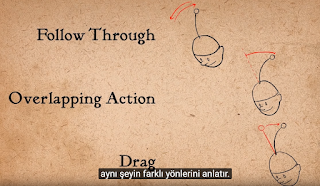Lessons from tutorial watched.
The illusion of life (Vimeo) https://vimeo.com/93206523
1. Squash and Stretch: Gives the illusion of weight and volume to the moving character.
2. Anticipation: Provides an audience an idea or anticipation of what character is about to do next.
3. staging: It is a presentation of an idea so that it is clear.
4. Straight ahead and pose to pose: pose to pose is started with key drawing drawn at intervals throughout the scene.
straight ahead: Transition of an object from one shape to another and so on.
5. Follow through and overlap: when the main body part of a character stops, other parts continue to follow up and slowly rest, nothing here gets stopped once.
6. Slow in and Slow out: more drawing makes the action slower while fewer drawing makes action faster.
7. Arcs: only a few exceptions follows arcs or a circular path. Arcs give animation natural action and better flow.
8. Secondary Action: addition action in the scene used as a supplement of a new one in order to reinforce it and provide more dimension.
9.Timing: more drawing between poses= slow the action/smooth, less drawing between poses= Action is fast and crispier.
Timing maintains the appearance of an object with an influence to physics.
Timing maintains the appearance of an object with an influence to physics.
10. Exaggeration: presenting in a very wild and extreme form.
11. solid drawing: using your character in 3d space which helps them give volume and weight.
12. Appeal: Overal quality of your animation that gives charms to viewers eyes. Its a beauty of the action.
Next Tutorial:
Squash and stretch: https://www.youtube.com/watch?v=uDqjIdI4bF4&feature=youtu.be
1. Squash and stretch:
It gives you an idea of objects.
keep the volume of an object consistency in every transition. Be aware of the proportion. In other word, the overall volume must remain the same.
2. Anticipation:
Winding up for a wind-up. make more body movement to show the action which is going to happen.
3.staging: where the concept should be clear. It can be applied to acting, timing, camera angle, and position and setting.
you should be in full control of where the audience is looking.
camera and angle: Faraway is good for big action and closeups are good for expressions. the actor here should be either in the center of a screen or one of a third of the script.
Timing: various action should be separated and shown in order to give a viewer clear information. ( controlling viewers eye.)
Conveying ideas to Viewers' eye: include some related scene or happening to give a flavor to your animation. for example, if a character is sad and walking by, you might add a rainy weather scene.
or you can narrate a scene with surrounding things as well. If someones poor just add the worn out stuff as their belonging and vice versa.
4. Straight idea and pose to pose straight. ahead- draw each drawing one by one basically animating as you go on. This animation method is good for unpredictable action such as fire, water particles, clouds and dust, explosions.
pose to pose: Here you draw the beginning and end action and fill the middle section. It is better for the most action. you can have a good idea what action gonna look like. their idle shape remains the same throughout the animation. and mostly recommended.
5. Follow Through and overlapping action and Drag:
This method adds more realism in the scene.
6. Slow in and slow out: With the acceleration or a movement of an object, its reaction varies where the speed of transition changes significantly. Use it wisely. This helps to make the animation smooth.
The drawing should be even. only add up in the beginning and at the end.
Arc: Circular movement.
Secondary Action: Primary action and secondary action. Secondary action mainly gives the idea of a happening and adds a lot more information to the scene.
Do not let secondary action dominate the primary action.
Timing:
Exaggeration: More convincing and add more to it. like if sad, go sadder, happy, happier, etc
Solid Drawing: 3d Knowledge, in a circle, make it curve intersection, in spheare, lines should match vanishing point.
It's always good to draw your character firswith basic shapes like sphere, cubes, cylinders.
It's always better to cover less detail cause, animation them later would be more complicated.
Character or object shapes should be aligned with respect to the perspective grid.
overlap shapes in camera to make more dimensional.
Avoid straight or symmetry lines while drawing character.
Avoid twinning: the same thing done by body parts at the same time.
Appeal: Interseting, likeable, dynamic design,
Use a variety of shapes, there is no limit to the spectrum of a crazy configuration that character can have. every good character starts with better shapes
play with proportion.
Find out character personality and enlarge their body parts.
Keep it simple with details.
Watched some of the tutorials which showed, how the character can be made better using wright proportion and manipulating their body parts.
In Software: did some animating stuff.









No comments:
Post a Comment